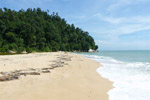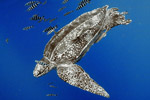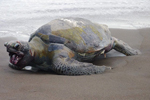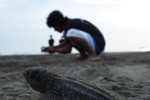
Dead sea turtles confiscated by the Philippine National Police (PNP). Photo by: PNP-SBU/PIA.
On Friday, eleven Chinese fishermen were caught by Filipino police with 555 marine turtles, 378 of which were dead. Officials in the Philippines have since released the 177 living turtles. But the incident has sparked an international standoff between the Philippines and China as the Chinese nationals were arrested in disputed waters in the South China Sea.
The Philippines has charged nine of the 11 poachers over the incident—two were released because they were minors. Those charged could face 12-20 years in prison for poaching a Critically Endangered species, in this case the Hawksbill turtle (Eretmochelys imbricata). But China has demanded the release of the remaining fishermen and the boat, which was confiscated.
The Chinese fishermen were apprehended about on the Banyue Reef, about 95 kilometers (60 miles) off the coast of Palawan, a Filipino island, and may face illegal entry charges as well as the area falls into the Philippines’ exclusive economic zone.
But China has sent a diplomat to Palawan to check on the fishermen and ask for their release. China has called the arrests “provocative.”

Dead sea turtles confiscated by the Philippine National Police (PNP). Photo by: PNP-SBU/PIA.
However the Philippine’s Interior Secretary, Mar Roxas, defended the actions by the Philippine National Police (PNP) Maritime Group.
“What I can say is that it was a normal routine patrol. We are just following the law…The area was just [90 kilometers] away from Philippine soil. How can that be provocative?” he said. “It’s also in accordance with an international treaty on the protection of endangered species, of which both the Philippines and China are signatories.”
At least two marine turtle species were found on the boat, Hawksbill sea turtles and green sea turtles (Chelonia mydas), which is categorized as Endangered by the IUCN Red List. Of the surviving turtles, 11 were hawksbill and 91 green marine turtles.
For millennia, sea turtle meat and eggs were important part of many peoples’ diets around the world. However, overhunting, pollution, climate change, and killed as bycatch by industrial fisheries have pushed all of the world’s marine turtles toward extinction. Of the seven marine turtles, two are listed as Critically Endangered, two as Endangered, two as Vulnerable, and one as Data Deficient. All seven, however, are listed as Appendix I on the Convention on International Trade in Endangered Species of Wild Fauna and Flora (CITES), meaning that commercial trade is illegal for all marine turtles.

The hundreds of dead sea turtles have sparked an international incident. Photo by: PNP-SBU/PIA.

Carapaces of dead sea turtles. Photo by: PNP-SBU/PIA.
Related articles
Malaysia imperils forest reserves and sea turtle nesting ground for industrial site (photos)

(04/15/2014) Plans for an industrial site threaten one of Malaysia’s only marine turtle nesting beaches and a forest home to rare trees and mammals, according to local activists. Recently, the state government of Perak approved two industrial project inside Tanjung Hantu Permanent Forest Reserve. But activists say these will not only cut into the reserve, but also scare away nesting turtles from Pasir Panjang.
Collateral damage: new findings shed light on the full impact of commercial fishing

(04/09/2014) Aside from reducing the populations of the species sought for capture, commercial fisheries are also killing thousands of nontarget creatures such as sharks, albatross, and sea turtles, collectively referred to as “bycatch.” However, the full extent of the problem is only beginning to be grasped.
A Turtle’s Tale: researchers discover baby turtles’ kindergarten (photos)

(03/14/2014) Kate Mansfield, at her lab in the University of Central Florida, is holding a baby loggerhead turtle, smaller than her palm, painting manicure acrylic on its shell. When the base coat dries out, she glues on top a neoprene patch from an old wetsuit with hair extensions adhesive. Finally, she attaches a satellite tracker on top, the size of a two “party cheese” cubes, with flexible aquarium silicone, powered by a tiny solar battery. Now the little turtle is ready to be released back into the ocean.
Leatherback sea turtle no longer Critically Endangered

(11/26/2013) The leatherback sea turtle—the world’s largest turtle and the only member of the genus Dermochelys—received good news today. In an update of the IUCN Red List, the leatherback sea turtle (Dermochelys coriacea) has been moved from Critically Endangered to Vulnerable. However, conservationists warn that the species still remains hugely endangered—and in rapid decline—in many parts of its range.
Longline fisheries in Costa Rica hook tens of thousands of sea turtles every year

(11/14/2013) Hundreds of kilometers of commercial fishing lines slither along coastal waters in Costa Rica, hooking thousands of mahi-mahi and many other marketable fish. But when scientists scrutinized fishermen’s catch, they were shocked by the staggering number of sea turtles accidentally snagged on the lines.
Ultraviolet nets significantly reduce sea turtle bycatch
(11/11/2013) Bycatch, a side-effect of commercial fishing in which non-target species are accidentally caught, is linked to severe population declines in several species. Sea turtles are particularly impacted by small-scale coastal gillnetting practices, in which large nets are deployed and indiscriminately snag anything of a certain size that attempts to swim through them. However, that may soon change.
California celebrates its inaugural Pacific Leatherback Conservation Day with sobering reality

(10/15/2013) On an isolated beach in Bird’s Head Peninsula, Indonesia, a female leatherback turtle shuffles out of the ocean and onto the shore, ready to lay her eggs. Under the cover of night she excavates a hole in the sand, depositing anywhere from 80 to 100 eggs inside. Using her flippers she flicks sand over the eggs, hiding them from potential predators. Then, shuffling away, she returns to the turquoise waters ready to make an 8,500-mile journey across the Pacific Ocean to the California coast.
Are sea turtles responsible for lower fish catches in India?

(08/29/2013) Fishing communities on Agatti Island in Lakshwadeep, India, blame their reduced fish catch on green turtles; according to them, green turtles chomp their way through the seagrass beds lining the shallow reef waters that are essential for fish to breed. This leads some in the community to clandestinely kill sea turtles and destroy their nests.
Eighty sea turtles wash up dead on the coast of Guatemala

(08/27/2013) An assortment of marine animals and birds reside along the black volcanic sand beaches of Guatemala’s Pacific coast, but lately both residents and visitors on the southeast beaches of the country have observed a tragic event – the stranding of dead sea turtles.
Eighty dead sea turtles have been recorded since the first week of July.
Suspects arrested in Costa Rican sea turtle conservationist’s murder
(08/03/2013) Eight suspects were arrested during early-morning raids Wednesday in the murder of Costa Rican sea turtle conservationist Jairo Mora.
Sea Shepherd to name new ship after slain sea turtle activist
(06/28/2013) Marine conservation group Sea Shepherd will name its newest vessel after Jairo Mora Sandoval, a sea turtle conservationist who was slain on a Costa Rican beach last month.
Reward for information on sea turtle conservationist’s murder reaches $56,000
(06/13/2013) Conservation organizations and individuals have raised $56,000 for information leading to the arrest and conviction of turtle egg poachers who murdered Jairo Mora Sandoval, a 26-year-old sea turtle conservationist earlier this month.
Costa Rican environmentalist pays ultimate price for his dedication to sea turtles

(06/10/2013) On the evening of May 30th, 26-year-old Jairo Mora Sandoval was murdered on Moin beach near Limón, Costa Rica, the very stretch of sand where he courageously monitored sea turtle nests for years even as risks from poachers rose, including threats at gunpoint. A dedicated conservationist, Sandoval was kidnapped along with four women volunteers (three Americans and one from Spain) while driving along the beach looking for nesting sea turtles. Sandoval was separated from the women—who eventually escaped their captors—but the young Costa Rican was stripped naked, bound, and viciously beaten. Police found him the next day, face-down and handcuffed in the sand; Sandoval died of asphyxiation.
